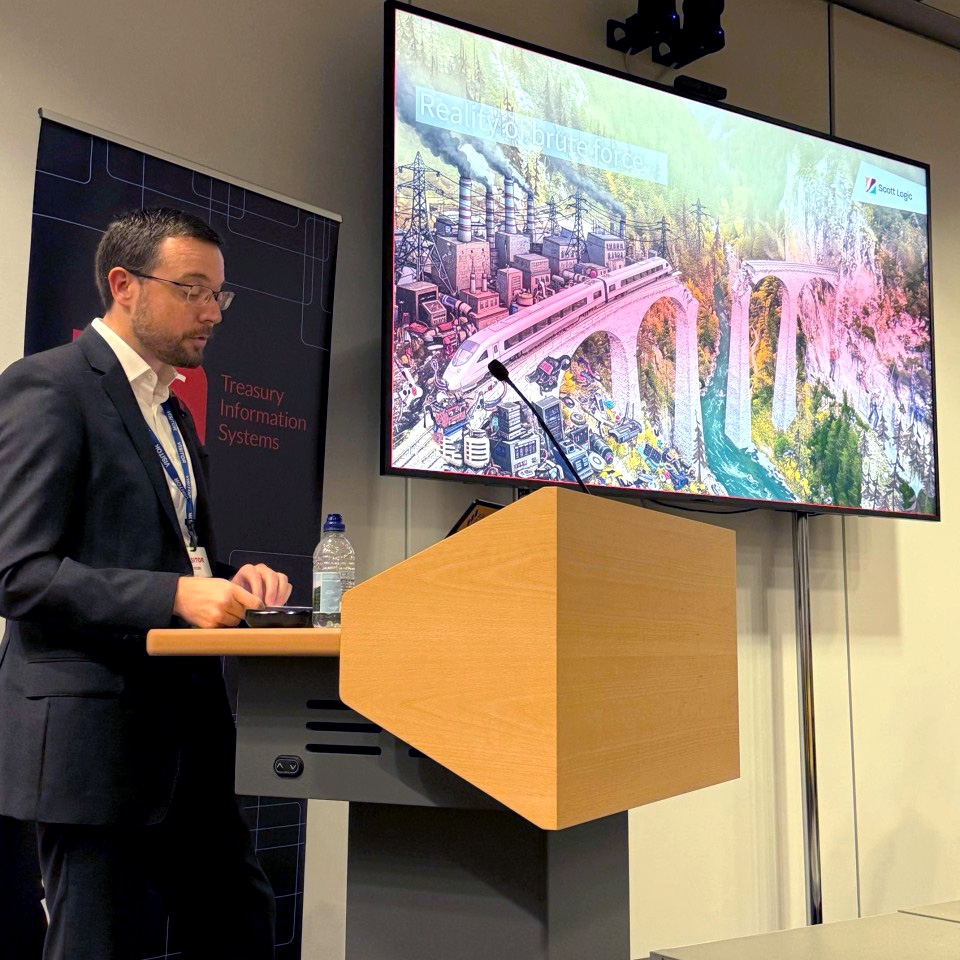Last week, we had the privilege of speaking at HM Treasury at the ID25 (Innovation Day) event on the crucial topic of balancing AI innovation with sustainability.
Joined by Suzanne Angell, our Public Sector Director, we addressed government and industry leaders about how the UK can lead in developing AI systems that are both powerful and sustainable.

Reframing the conversation
The discourse around AI and sustainability often positions them as competing forces – innovation pushing us forward while sustainability acts as a brake. We proposed a different perspective: innovation and sustainability strengthen each other. As Suzanne eloquently put it, “Innovation without sustainability is short-lived. Sustainability without innovation is stagnant.”
This isn’t merely an environmental concern; it’s central to building AI systems that deliver lasting value. True sustainability encompasses environmental, economic, and technological considerations, aligning with the UN Sustainable Development Goals that the UK government has committed to.
The Tech Carbon Standard: A Framework for Action
At Scott Logic, we’ve developed the Tech Carbon Standard to help organisations understand and manage their technology footprint. This open source framework, now cited in the GOV UK Service Manual, helps bridge the gap between sustainability professionals and technologists by providing a common language and approach.
The standard highlights three critical areas:
-
Upstream emissions – The hardware manufacturing, software development, and content creation that can make up 50–60% of technology’s environmental impact.
-
Operational emissions – The running of technology services, which gets most of the attention today.
-
Downstream emissions – The impact on citizens and businesses using government services.
Most organisations are shocked to discover that often the majority of their environmental impact comes from hardware procurement rather than operational energy use. This insight alone can transform decision-making.
The reality of GenAI models
While celebrating AI’s potential, we must confront uncomfortable truths about current approaches, particularly with many large generative models. The industry has adopted what I described as a “brute force” approach – throwing massive computing resources at problems, with corresponding energy and resource requirements.
This approach is fundamentally unsustainable for several reasons:
-
Enormous compute and energy requirements, often directly powered by fossil fuels due to grid limitations.
-
Generation of substantial e-waste as specialised hardware is quickly obsolesced.
-
Degradation of the information space as models train on increasingly synthetic content.
-
Lack of transparency about true environmental costs.

Illustrating brute force AI development through the use of a metaphor of a train trying to bridge a gap, we explained how current AI development is at risk of failure under its own resource requirements and the risk of model collapse. Some AI data centres are being powered directly by gas turbines because there simply isn’t time to sort out grid infrastructure – which isn’t the sustainable future we should be building or supporting.
This is not an outlier perspective
We have done an extensive literature review of industry and academic material relating to AI sustainability, and it provides a solid evidence base for these positions. Recently, Dr Sacha Luccioni recorded a TED Talk on this topic, and it’s a very compelling 10-minute watch.
A more sustainable path forward
We proposed a human-led approach to AI, one that empowers people with AI tools rather than attempting to replace them. This means:
-
Measuring first – Understanding the full lifecycle impact of AI systems using frameworks like the Tech Carbon Standard.
-
Embedding sustainability into procurement – Using standards and spend controls to incentivise sustainable AI.
-
Right-sizing models – Using domain-specific models rather than general-purpose ones for specialised tasks.
-
Distributing computing – Moving from centralised cloud-only models to a mix including private infrastructure and edge AI.
The evolution from “clock towers to wristwatches” provides a useful parallel. Just as timekeeping evolved from public clocktowers to personal watches, AI is evolving from massive centralised systems to more distributed and personalised ones.
Edge AI (running models directly on end-user devices) offers particular promise. It diffuses energy demand, leverages existing devices (reducing e-waste), and benefits from the rapid innovation in smaller, open-source models.
Maximising existing assets, diffusing power demand
A critical point to emphasise here: when we advocate for running AI on end-user devices, we’re not proposing an increase in hardware consumption (although of course there is a danger of a rebound effect). Rather, we’re promoting the efficient utilisation of hardware that already exists. Consumer and business devices typically have significant unused computing capacity. Smartphones, laptops and desktops often run at a fraction of their processing potential.
By “sweating these assets” to extract more value from hardware already manufactured and distributed, we avoid the substantial upstream carbon costs of creating new, specialised AI hardware. This approach acknowledges that the environmental impact of manufacturing devices has already occurred; maximising their utility before end-of-life becomes the most sustainable path forward.
This aligns with circular economy principles: extending product lifespans, maximising resource utilisation, and reducing the demand for new manufacturing. The beauty of this approach is that it transforms what might initially appear as a contradiction – running AI across more devices – into a sustainability advantage. It does this through the more efficient use of existing resources across a range of locations that are easier to decarbonise (moving the compute is often easier than moving the power) rather than centralised locations that suffer from grid bottlenecks. There is also the potential to run AI on business and end-user devices overnight – when they are not used – scheduled for times when there is lower-cost and lower-carbon electricity.
The UK opportunity
What might initially appear as constraints for the UK – our regulatory environment and grid capacity limitations – can actually drive innovation rather than inhibit it. The UK has a proud history of pragmatic, efficient engineering excellence, from ARM microprocessors to Formula 1 and Rolls Royce jet engines.
Our position enables us to focus on developing AI that is:
-
more efficient in its use of resources
-
more transparent in its operations
-
more trustworthy for sensitive applications
-
more tailored to specific domains – particularly those in scientific and highly regulated areas
Rather than competing on raw scale, we can lead in creating specialist models that excel in specific domains while maintaining a smaller footprint. This approach plays to our strengths in scientific innovation and high-end, regulated engineering.
Looking ahead
After the presentation, there was a panel discussion chaired by Jess McEvoy with government panellists exploring concrete steps forward. There was a strong consensus that:
-
Sustainability must be baked into the AI development process from the beginning
-
Central standards coupled with distributed responsibility provide an effective governance model
-
The UK has an opportunity to be a global leader in sustainable AI innovation
As we concluded, UK innovation is the key to sustainable AI. By focusing on measurement, embedding sustainability in procurement, right-sizing models, and embracing a range of computing approaches, we can build AI systems that deliver tremendous value while respecting planetary boundaries.
Scott Logic works with public and private sector organisations to design, build and deploy technology that makes a measurable difference to people’s lives. You can learn more here about our approach to sustainable technology.
After the event, I recorded the talk for publication on YouTube. You can watch it here:


